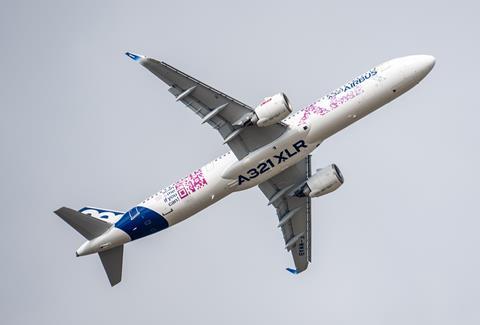Airbus’s long-range A321XLR has made its air show debut, as the airframer aims to certify the CFM International Leap-1A version by the end of this year.
Executive vice-president for programmes Philippe Mhun tells FlightGlobal that Airbus has agreement on the twinjet’s technical configuration for the twinjet following discussions with the European Union Aviation Safety Agency – notably regarding the aft centre tank, critical to the XLR’s range of up to 4,700nm.
Three flight-test aircraft – both Leap- and Pratt & Whitney PW1100G-powered models – are participating in the certification campaign, but the regulatory discussions on the XLR’s modifications from the A321neo mean they are not identical.
“They’re not completely, at the same time, reflecting the final configuration that we agreed with EASA,” says Mhun.
Some of the prototype A321XLRs have tested extended belly fairings for aerodynamic assessment, which are not representative of the final material, while others have been fitted with the latest structural reinforcement and fuel-tank protection.
“We had to exchange with the authority, taking their inputs in terms of improving the technical baseline of the aircraft. We have agreement now on the technical baseline,” says Mhun.
“The flight-test aircraft will reflect, at some point in time, the structural reinforcement and internal [fuel-tank] liner that we agreed on.”

While the XLR has wing fuel capacity of 15,328 litres and standard centre-tank capacity of 8,200 litres, it features a high-capacity aft centre tank able to hold a further 13,100 litres. The aircraft also has options for an additional 3,120-litre forward tank.
The aft tank’s size raised concerns over the potential for large fuel spillage and fire in the event of an accident.
Mhun says the protective liner is designed for the interior of the tank and its task is to contain the fire risk long enough for passenger evacuation.
“If you have a kind of puncture in the tank, [the liner is] a way to delay and reduce the leak rate to avoid getting fuel on the ground,” he says.
Mhun says the principle resembles the fitting, two decades ago, of Kevlar lining to the inside of BAC-Aerospatiale Concorde tanks to protect against fuel spillage from debris impact.
“The spirit of it could be similar, but the content is different,” he says, because the materials involved have advanced.
Rather than being puncture-resistant, Mhun states, the lining is soft and “optimises” such that “the hole in the liner would be smaller than the hole in the [tank] structure”.
But he stresses that the XLR’s range is not compromised by the liner’s presence. “We’re able to deliver on the mission agreed with the customers,” he insists.
Route-proving will take place to test the cabin and long-haul capabilities under real-world operational conditions before the XLR enters service in the second quarter of next year.
That the CFM-powered aircraft is ahead of the Pratt & Whitney jet is unconnected to the durability issues currently affecting a number of in-service Pratt & Whitney powerplants, says Mhun.
“As per the initial plan, it’s CFM certification first then Pratt & Whitney – that’s just reflecting the choice of customers,” he adds.
Mhun says flight-test pilots have provided positive feedback during demonstration preparations for the Paris show. “They’re really very happy with manoeuvrability of the aircraft,” he says.
“That’s something we incorporated on top of some of the big topics on flight control and load improvement. Performance-wise we’re happy with what the aircraft is delivering.”
Airbus’s most recent specification documentation for the A321neo lists two initial weight variants for the XLR – designated WV099 and WV100 – with the same maximum take-off weight of 101t, but different maximum landing and zero-fuel weights.


























